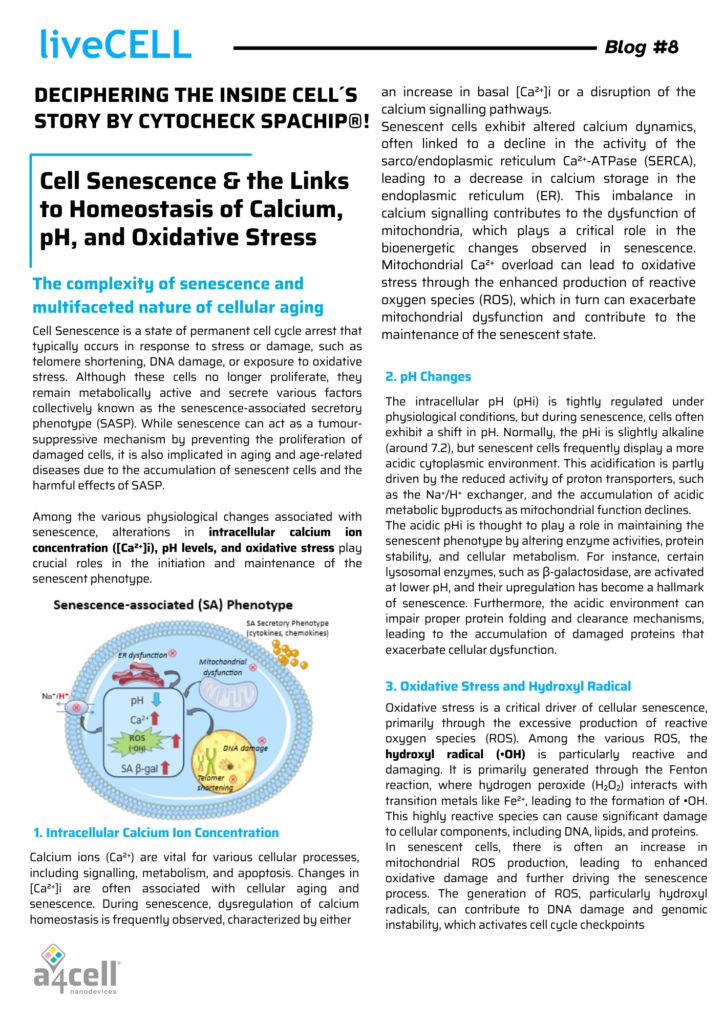
Welcome to A4liveCell Blog #8!
Cell Senescence & the Links to Homeostasis of Calcium, pH, and Oxidative Stress
As our understanding of cellular biology evolves, one of the most compelling areas of research is the phenomenon of cellular senescence—a state of permanent cell cycle arrest that occurs when cells experience stress or damage. Factors such as telomere shortening, DNA damage, or exposure to oxidative stress trigger this process. While senescence can act as a protective mechanism to prevent damaged cells from proliferating, it also plays a key role in aging and age-related diseases due to the accumulation of senescent cells and the harmful effects of the molecules they secrete. Understanding the intricate mechanisms driving cellular senescence can unlock new possibilities for combating aging-related disorders, and that’s where cutting-edge technology like CytoCHECK’s SPAchip® comes in.
What Happens Inside Senescent Cells? The Roles of Calcium, pH, and Oxidative Stress
During senescence, cells undergo various physiological and metabolic changes that disrupt their normal functions. Three critical factors that play pivotal roles in the initiation and maintenance of the senescent state are the dysregulation of calcium homeostasis, shifts in intracellular pH (pHi), and oxidative stress.
1. Calcium Ion Dysregulation: The Intracellular Signal Gone Awry
Calcium ions (Ca²⁺) are essential for a variety of cellular functions, including signaling, metabolism, and apoptosis. In senescent cells, there is often dysregulation of calcium homeostasis, characterized by a disruption in calcium signaling pathways and a decrease in the storage capacity of the endoplasmic reticulum. This imbalance can lead to mitochondrial dysfunction, exacerbating oxidative stress and further promoting the senescent state.
2. pH Changes
Under normal conditions, intracellular pH (pHi) is slightly alkaline, around 7.2. However, in senescent cells, pHi tends to become more acidic, driven by reduced proton transporter activity and the buildup of acidic metabolic byproducts as mitochondrial function declines. This acidic environment alters enzyme activities and protein stability, further contributing to cellular dysfunction.
3. Oxidative Stress and Hydroxyl Radical
The accumulation of reactive oxygen species (ROS), particularly hydroxyl radicals, is a key driver of cellular aging. In senescent cells, oxidative stress leads to DNA damage and genomic instability, reinforcing the cycle of cellular dysfunction and contributing to the maintenance of the senescent phenotype.
4. Induction of β-Galactosidase
Senescence-associated β-galactosidase (SA-β-gal) is a key biomarker for detecting senescent cells. It becomes upregulated in lysosomes under acidic conditions, which are common in senescent cells. Its activity is linked to the enlargement of lysosomal compartments and can be easily detected via histochemical assays, making it a reliable indicator of cellular senescence.
5. Cell Senescence and SPAchip technology
SPAchip® is an innovative technology enabling real-time intracellular analysis of living cells using fluorescence. It works by functionalizing silicon chips with chemical or biological probes, which are harmlessly absorbed by cells. This allows the detection of critical cellular messengers like pH, Ca²⁺, and ROS. SPAchip® also supports the tracking of enzyme biomarkers, such as SA-β-gal, making it a powerful tool for studying senescence.
6. Conclusions
The convergence of calcium signaling, pH dysregulation, and oxidative stress drives cellular senescence, leading to permanent cycle arrest. SPAchip® provides valuable insights into these processes, offering researchers the ability to monitor and target senescent cells in age-related diseases and therapeutic interventions.
Get ready for the future with A4Cell’s CytoCHECK SPAchip®, where innovation in cellular detection meets therapeutic advancement!
Share your experiences with us, and let’s collaborate to build something remarkable together!







